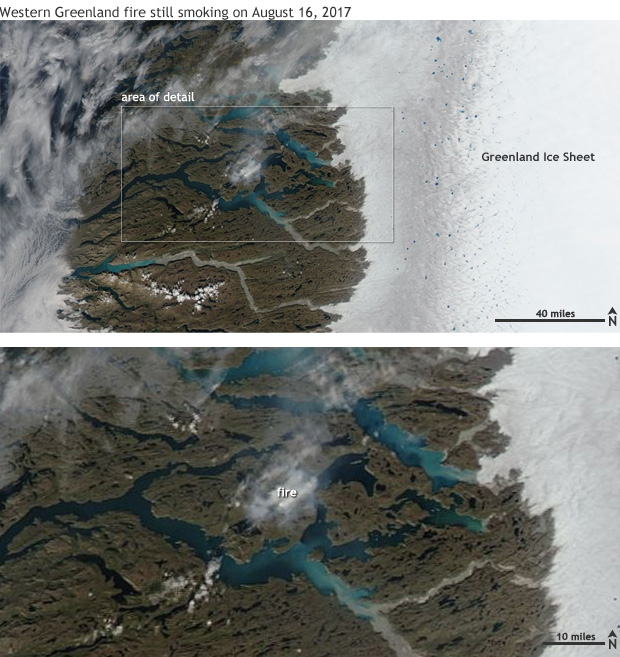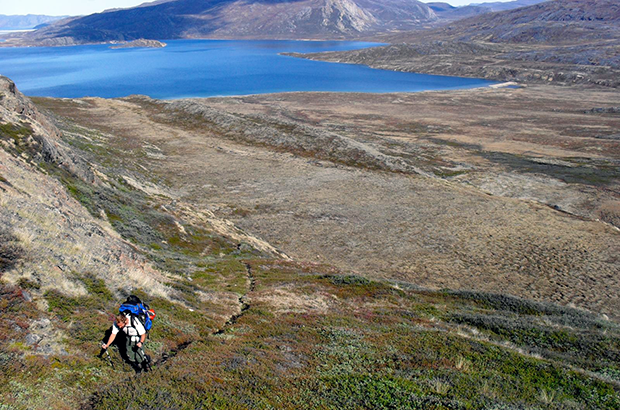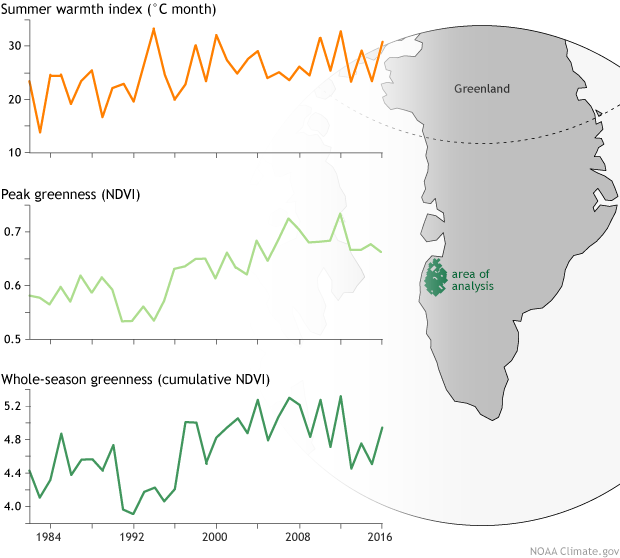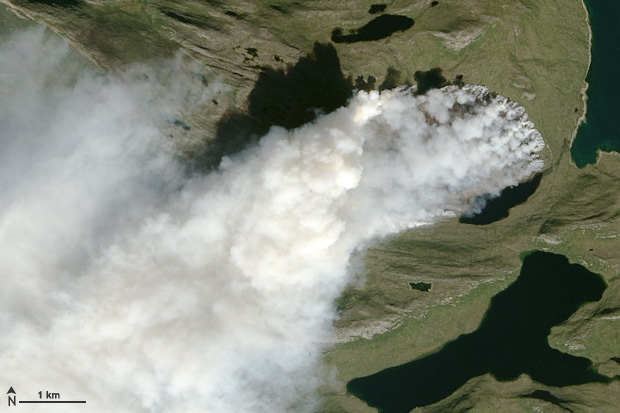Wildfire
still burning in Greenland tundra in mid-August 2017
18
August, 2017
An
unusually large fire continued to burn in the tundra of western
Greenland on August 16, 2017—a rare occurrence for a place better
known for its mile-thick ice cap and glacier-filled fjords.
Although
it may have started earlier, the fire was first noticed on satellite
during late July. By mid-August, it and other smaller fires coastward
of the small town of Kangerlussuaq had burned through thousands of
acres, according to local
news reports. The
cause of the fire hasn’t been reported, but both people and
lightning have been known to start fires in the area.

An
unusually large fire that started at the end of July was still
burning as of August 16, 2017. NASA Aqua satellite image from the
Worldview website.
According
to Greenland experts quoted in a roundtable
discussion published
by NASA’s Earth Observatory, wildfires in Greenland are rare but
not unheard of, although there are no truly long-term records of fire
activity in the area. Still, scientist Stef Lhermitte at Delft
University of Technology in the Netherlands showed preliminary
evidence that
2017 has seen the largest amount of wildfire activity since the start
of the NASA MODIS satellite record in 2000.
Large
fires in Greenland are more than a curiosity. In addition to the
public safety issues (people do live, hike, hunt, and camp in the
area), there are environmental ones. All fires are a source of carbon
dioxide and other greenhouse gases. Fires are also a source of sooty
“black carbon,” which rises above the flames and drifts with the
smoke to higher elevations. Eventually, it falls on the ice sheet,
turning it from pristine white to a darker color. And just like how
wearing a black shirt on a sunny day makes you feel hotter, with the
ice wearing its black carbon shirt, it melts
faster than
it would due to climate warming alone.
What’s on fire?
During
the summer, the interior of Greenland remains ice-cold, but some of
the mountainous coastal areas ringing the island are ice-free. The
vegetation across the region can vary hugely based on latitude,
altitude, slope aspect, and closeness to the ice sheet. Wetter,
milder areas near the coast may have shrubs, small trees, and mosses,
while areas farther inland, close to the ice sheet, are drier and
more like cold grasslands. The area where this fire is burning is
right near the transition between the wetter coastal climate and the
drier continental climate near the ice sheet.

A
view of the variety of plants and shrubs along the Arctic Circle
Trail near Sisimiut, Greenland, about 50 miles southeast of the
fire's location. Photo by
Destination Arctic Circle via Creative Commons license.
After
looking at satellite images of the fire’s
progression,
Arctic vegetation expert Donald Walker wrote via email:
The first image, taken July 31, is low resolution, but it shows the exact location of the initial fire without much smoke yet to mask the terrain. It started between two small drainages in area of homogenous mesic tundra.
An infrared-enhanced satellite image of the fire before it spread. Satellite image from the European Space Agency, pulled as a screenshot from Stef Lhermitte's Youtube animationof the fire progression.
The second one [acquired by a commercial satellite company and published by the BBC] shows a larger area affected by fire, which spread mainly west from the initial ignition into rolling heterogeneous glacial terrain. The fire has burned across a variety of vegetation types, including some glaciated bedrock outcrops. The image is not sharp but the lighter-toned areas look to be burned, south-facing slopes with drier vegetation, where the fire may have exposed bedrock or bare soils.
The third image when enlarged gives a good impression of the vegetation burning on the eastern edge of the fire. Probably not on peat, but organic-rich mineral soils. I would guess it is mainly mesic graminoids [grass-like plants], prostrate dwarf-shrub, moss tundra, with few or no erect shrubs. The yellowish-brown tone of the tundra indicates a lot of standing dead sedges or grasses.
NASA Landsat 8 image of the Greenland fire on August 3, 2017. NASA Earth Observatoryimage.
There also hints of spots of cryoturbation by frost boils, which would suggest thin organic layers and relatively high soil pH, which would limit the occurrence of many erect shrubs, such as dwarf birch and common members of the Ericacea plant family, such as crowberry, Labrador tea, and lingonberry. Brighter green vegetation, possibly shrubby, occurs in a few of the drainages and at the base of some hills, where there is probably more water from snow drifts.
I have been fooled many times, though, so until we have confirmation of the actual species present and the good ground-based photographs of the vegetation it would be good to exercise caution with this interpretation.
Is Greenland finally living up to it’s name?
According
to the latest report from the Intergovernmental Panel on Climate
Change, issued in 2014, as temperatures warm across the globe, they
have been rising the fastest across the Arctic. This especially holds
true during the summer months. Tied to this increase in warmth, the
IPCC notes that vegetation has greened across a third of the Arctic
from 1982-2012, including areas along western Greenland (IPCC AR5
Working Group 2).
In
response to our request, Uma Bhatt of University of Alaska-Fairbanks,
ran a temperature and vegetation analysis for the area of western
Greenland where this summer’s fires were occurring. (Bhatt and her
colleagues do a similar assessment each year as part of the Arctic
Report Card.)
The satellite-based analysis confirmed that during past several
decades, there has been a “greening” and warming trend in the
area.

Satellite-based
analysis of average summer warmth (top), peak vegetation greenness
(middle), and cumulative greenness in the area where this summer's
large fire occurred. Despite ups and downs from year to year, a clear
warming and greening trend is clear, especially since the 1990s. All
three hit a recent high in 2012, the same year that the area of
surface melt on the Greenland Ice Sheet set
a new record. Analysis by
Uma Bhatt, based on NDVI data
from NOAA's AVHRR series of satгellites.
Increasing
satellite greenness can mean more plants,
leafier or bigger plants, or a transition from grasses and small
plants to taller, leafier shrubs. In many parts of the Arctic,
this shrub
take over is
underway, but long-term, ground-based observations for Greenland are
sparse. Whatever the nature of the change, it appears that in western
Greenland, the island’s name is slowly becomingnot
a misnomer.
Another
Greenland expert and Arctic Report Card author we talked to for this
story, Marco Tedesco, used a different technique to do a preliminary
analysis of possible changes in fire-relevant climate conditions in
the exact location of the fire. He said that over the past decade
summer temperatures have been above-average, while precipitation has
been below-average, hinting that conditions may have become more
friendly to fires recently.
Bhatt
also pointed out that research has indicated a trend towards higher
sea level pressures over Greenland—and lower sea level pressure
elsewhere (Bhat 2013, 2017), especially since the 1990s. While not a
one to one relationship, high
pressures in the summer are
often associated with clear skies and warmer than average
temperatures, both of which can influence fire activity.
This
combination of warmer temperatures, increased plant life, and summer
dryness could increase fire risks in Greenland.
More to come
While
some scientists have speculated that the current fires may be burning
peat—a mixture of dead but only minimally decomposed plant material
located in a frozen or water-logged environment—the scientists who
provided input to this post were more cautious.
One
of the experts we consulted for this story pointed out that soil maps
of the area indicate that at least some of the soils in the area
are leaner and better drained, rich in humus, but not peat. As
we gather more information, we hope to have a follow-up story about
the soil and permafrost in the area and how they may be changing as
well. There is still a lot to learn about these fires burning in an
extremely remote corner of the world.
Climate.gov
thanks the following experts for providing input for this
article: Uma Bhatt, Donald Walker, Marco Tedesco, Martha Raynolds,
and Howard Epstien.
References
Bhatt,
U. S., Walker, D. A., Raynolds, M. K., Bieniek, P. A., Epstein, H.
E., Comiso, J. C., … Zhang, J. (2017). Changing seasonality of
panarctic tundra vegetation in relationship to climatic
variables.Environmental
Research Letters,
12(5), 55003. https://doi.org/10.1088/1748-9326/aa6b0b
Bhatt,
U. S., Walker, D. A., Raynolds, M. K., Bieniek, P. A., Epstein, H.
E., Comiso, J. C., … Polyakov, I. V. (2013). Recent Declines in
Warming and Vegetation Greening Trends over Pan-Arctic Tundra. Remote
Sensing,
5(9), 4229–4254. https://doi.org/10.3390/rs5094229
Jedrzejek-B,
Drees-B, Daniёls-FJA & Hölzel-N 2013: Vegetation pattern of
mountains in West Greenland – a baseline for long-term surveillance
of global warming impacts. Plant
Ecology and Diversity.
6, 3-4: 405-422.





No comments:
Post a Comment
Note: only a member of this blog may post a comment.